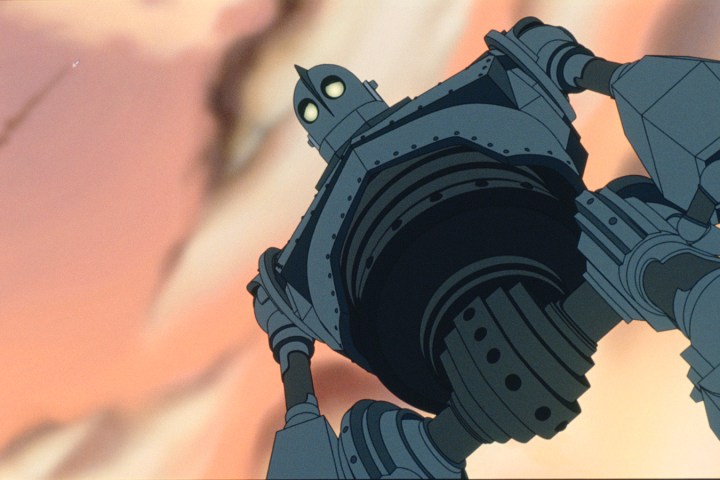
Nowadays, superhero movies are more common than most other Hollywood blockbusters. That wasn’t the case in 1999. Back then, not only were comic book films still few and far between but good ones were even rarer and more difficult to find. A lot has, of course, changed since then. Entire superhero-driven cinematic universes have been born, taken over Hollywood, and — in the case of Warner Bros.’ DC Extended Universe — even been put out to pasture. What hasn’t changed, however, is The Iron Giant‘s status as one of the best superhero movies that Hollywood has ever produced.
Directed and co-written by Brad Bird, The Iron Giant received immediate and widespread praise when it was originally released in August 1999, but it was a box office bomb. Thankfully, its poor financial performance didn’t stop it from gradually earning a special place in the hearts of a lot of comic book fans. In the years since its theatrical debut, the film has frequently been cited as one of the best American animated movies of the past 30 years, and it has become a comfort food-esque go-to for many of its admirers.
That is due, partly at least, to not only how well The Iron Giant tells its Cold War-era comic book plot but also how beautifully it depicts and explores the enduring, childlike appeal of superhero stories. It’s a film that understands exactly why figures like Superman and Spider-Man have held a place in our collective public consciousness for so long. Unfortunately, while comic book movies have only grown in popularity since The Iron Giant‘s release 25 years ago, it seems like the superhero genre at large has forgotten the film’s best and purest idea.
Punching bad guys isn’t the point

Superhero movies tend to all end the same way these days — that is with their heroes battling their villains in colossally destructive confrontations that always seem to completely level either multiple blocks or entire cities. The heroes win in the end and little mind is ultimately paid to the havoc that they helped wreak along the way. The world may invariably be saved, but it seems like almost every Marvel and DC movie now engages in a cynical, dystopian kind of cost-benefit analysis. So long as no civilians are actually killed onscreen, many superheroes movies seem perfectly fine looking past the toll that their often overblown climactic set pieces have on their fictional worlds (most of which look a lot like our own).
For a few minutes in its third act, it looks like The Iron Giant is going to embrace that trope, too. After the film’s titular, gigantic metallic being becomes briefly convinced that his young, human friend, Hogarth Hughes (Eli Marienthal), has been killed as part of an unmotivated attack by the U.S. Army, he transforms into an apocalyptic war machine capable of leveling every threat that comes his way. It looks, for a moment, like The Iron Giant is going to end with a dark display of pure vengeance, but then the opposite happens. Hogarth, it turns out, was just knocked unconscious, and when he runs back to his friend, he finds himself staring down the barrel of a laser cannon held by an unfeeling, red-eyed weapon of mass destruction.
‘You are what you choose to be.’

Hogarth doesn’t let the danger facing him stop him from trying to save the Giant, though. Referencing the death of a deer that they witnessed earlier in the film, Hogarth tells the Giant, “It’s bad to kill. Guns kill, and you don’t have to be a gun. You are what you choose to be. You choose.” His speech awakens his friend from his rage-fueled rampage. When the movie’s villain, a fascistic federal agent named Kent Mansley (Christopher McDonald), then orders an unsanctioned nuclear attack on him, the Giant is forced to fly up and meet the nuke in space before it can reach Hogarth’s town and kill everyone in it. Soaring through the air, the Giant remembers what Hogarth told him just moments ago. The young boy’s voice rings in his head, reminding him, “You are who you choose to be.”
“Superman,” the Giant says to himself just before crashing into Mansley’s nuke and forcing it to detonate in space — a safe distance away from Hogarth and his fellow citizens of Rockwell, Maine. The Giant, in other words, sacrifices himself in order to save a human world that has been driven to near madness by the Cold War from lighting itself on fire. He becomes, in his own way, Superman.
The Iron Giant’s ultimate lesson
Too many modern superhero movies, whether intentionally or not, visually associate heroism with violence. In their desire to deliver the biggest, most bombastic climaxes possible, many films end up forgetting what superheroes are actually supposed to represent and do. Their stories are not just meant to be about beating the “bad guys.” The Iron Giant reminds us of that. It’s a movie that earnestly argues that superheroes are not supposed to cause or engage in destruction, but do everything they can to stop it. They’re meant to protect the world, not contribute to its destruction. How else can they be figures that children look up to the same way Hogarth does the Giant?
It may be a testament to how far the superhero genre has drifted from its idealistic, hopeful roots that The Iron Giant‘s ending not only seems just as beautiful and moving now as it did 25 years ago but also more inspired and subversive. In its final moments, the movie chooses peace over chaos, and it is better for it.
The Iron Giant is available to rent now on all major digital platforms.
Services Marketplace – Listings, Bookings & Reviews
